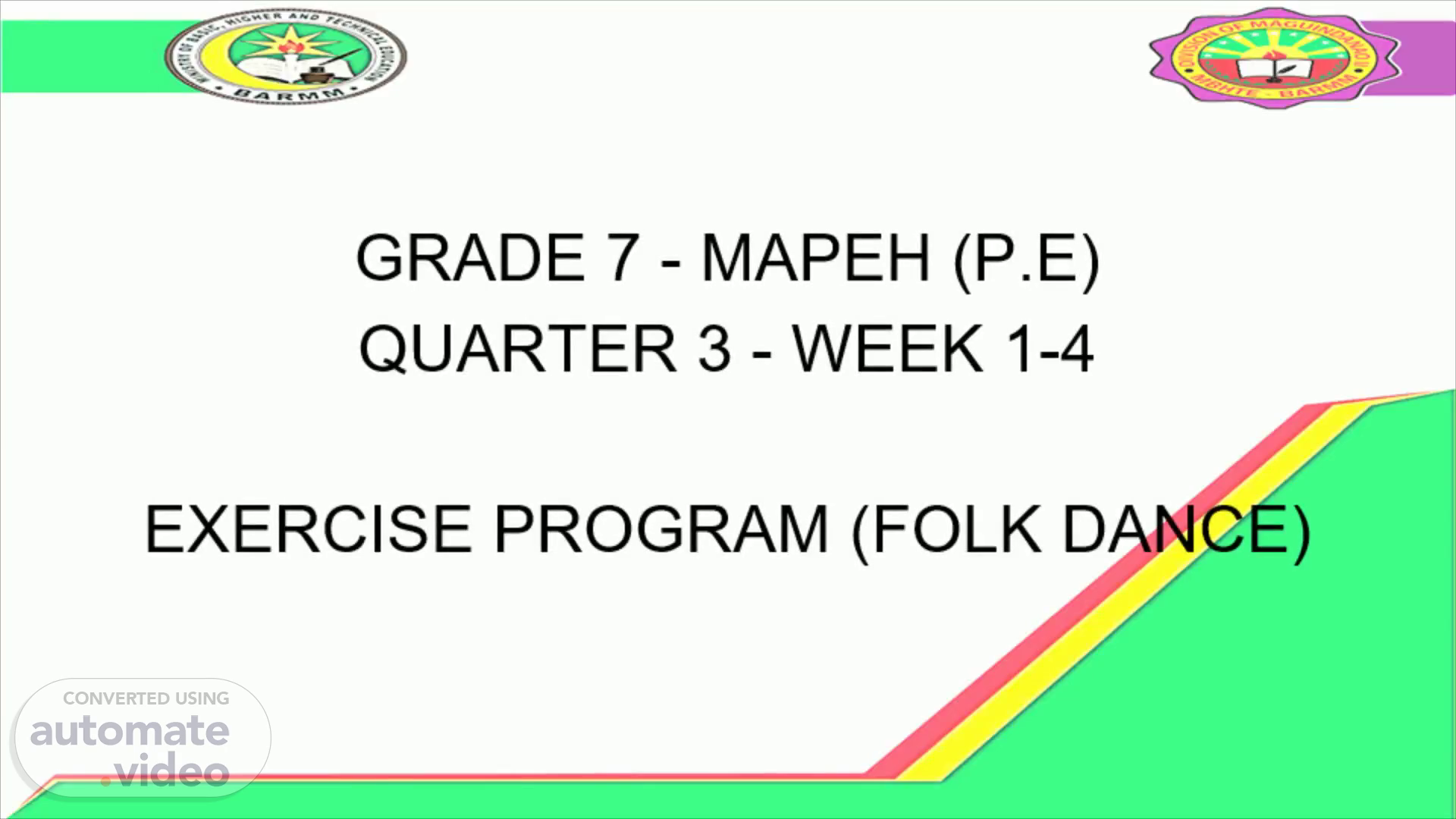
GRADE 7 - MAPEH (P.E) QUARTER 3 - WEEK 1-4 EXERCISE PROGRAM (FOLK DANCE)
Scene 1 (0s)
GRADE 7 - MAPEH (P.E) QUARTER 3 - WEEK 1-4 EXERCISE PROGRAM (FOLK DANCE).
Scene 2 (8s)
LESSON 1: Nature and Background of Folk Dance Nature and Background of Folk Dance Folk Dance refers to the dances created and performed collectively by the ordinary people. The term usually includes: so called “ethnic dances” such as those of the cultural community in the Cordillera, in Mindoro, Palawan, Sulu, and Mindanao; and the rural or lowland Christian dances, among the groups, like Ilocano, Pangasinan, Tagalog, Pampango, Bicol, Cebuano,Ilongo, and Waray. Folk dances may also be divided into the “regional”, which refers to dances particular to one locale area; and the “national”, which refers to those performed all over the country. A related term is “creative folk dance” which refers to character dances whose choreography uses folk steps and music. Philippine folk dances are diverse, and include religious, ceremonial, courtship, funeral, combative, exorcism, torture, comic, and game dances. They have been named after saints, heroes, teachers, foreign steps or dances, their countries or regions of origin, events, tribes, a combination of steps or of steps and places, and a combination of words. Philippine folk dances other than religious, cremonial, and a few social are performed with attention to detail and after meticulous rehearsals. Filipino ethnic groups still believe in the efficacy of dance as a means of communicating with deity. Christianized Filipinos too dance to plead with, or to thank the Virgin Mary or a patron saint..
Scene 3 (1m 7s)
As in Filipino religiousity, the influence of indigenous culture persists, despite colonization. Insects, reptiles, fowls, birds, simians, medicinal and fragrant plants, edible shoots, the national flower, bamboo nodes, and the sound of wind is it passess through the leaves have all been accorded recognition in Philippine Dance. Activities such as rice production, broom making, gold panning, fishing, tuba making, gathering of sweet potatoes, clams or honey, fetching of water, pot making, corm planting, and communal work have been reflected in Philippine folk dances. The dances use movements of the head, waist, arms, feet, throwing circling, swooping, offering, and crowning. Some dances feature flags, beating with sticks, and swaying motions such as those of drunkards. Hand or stage properties are used: fans, earrings, bench, food covers, hat, fish containers, pots, leaves, floral arches, coconut shells, wooden implements, chopsticks, and maypoles..
Scene 4 (1m 50s)
Forms of Philippine Folk Dances: 1. Rural Dance – best known and close to the Filipino heart, these dances are from the rural Christian lowlands, it also illustrates the fiesta spirit and demonstrate a love of life. Ex. Bakya-Salakot, Sayaw sa Bangko, Bulaklakan 2. Spanish Influence Dance – the coming of the Spaniards in the 16th century brought a new influence in Philippine life. They are named in honor of the legendary Maria Clara. Ex. Pandango, Lanceros, Rigodon, Cariñosa, Curacha 3. Mindanao Dance – Mindanao and Sulu were never conquered by Spain. The dances in Muslim however predated the Muslim influence. Singkilwas introduced after the 14th century; it was based on the epic legend of Darangan of the Maranao. Ex. Singkil, Pangalay, Sagayan, Maglangka, Kappa Malong 4. Cordillera Dances – these are the dances of mountain tribe in Northern Luzon, such as those of the Kalinga and Ifugao people. “Cordillera” a name given by the Spanish Conquistadors when they first saw the mountain rangers. Ex. Banga, Bendayan, Manmanok, Turayen, Uyaoy/ Uyauy 5. Ethnic/Tribal Dances – the cultural minorities that live in the hills and mountains throughout the Philippine Archipelago considered dances as a basic part of their lives. Rinampo and Talbeng are examples of these dances. Ex. Binanog, Inagong, Tinambol, Binaylan, Pinagkabula.
Scene 5 (2m 45s)
LESSON 2: Fundamental arms and feet position and Basic Steps in Folk dancing FUNDAMENTAL ARMS AND FEET POSITION.
Scene 6 (2m 59s)
. 3rd Position 4th Position 5th Position One arm raised sideward, the other arm overhead. One arm in a half circle in front, other arm raised overhead. Both hands raised overhead..
Scene 7 (3m 10s)
. B. FEET POSITION posiT10N 1st Position 2nd Position 3rd Position 4th Position 5th Position ILLUSTFuQTION Heels together, toes apart with an angle of 45 degrees. Astride sideward of about a pace or I foot distance. Heel of one foot close to the in-step of the the other foot. One foot in front of the other about a pace distance Heel of front foot close to the big toe of the rear foot..